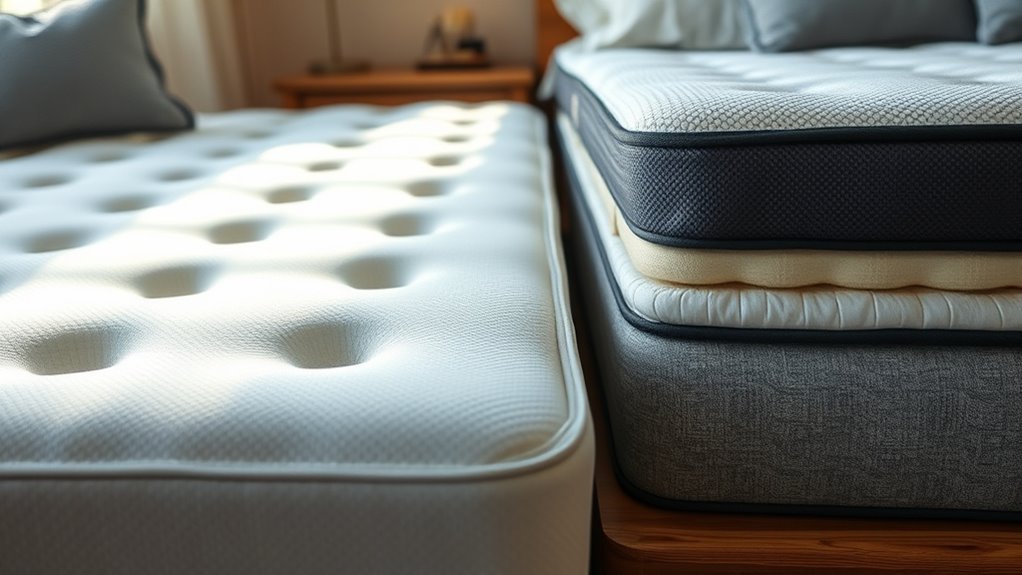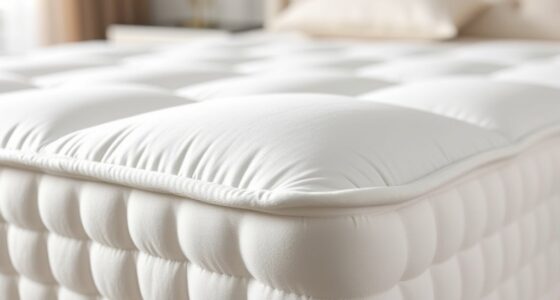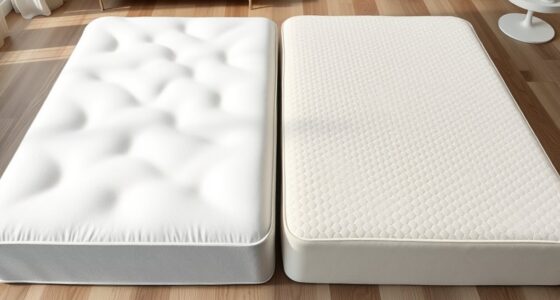If you’re choosing between memory foam and hybrid mattresses, consider your preferences for support, temperature regulation, and durability. Memory foam offers excellent body contouring and absorbs movement, making it ideal for pressure relief and minimizing partner disturbance. Hybrids combine foam with coils for better airflow, edge support, and a balanced feel, often lasting longer. Exploring the pros and cons further will help you find the perfect fit for your sleep needs.
Key Takeaways
- Memory foam contours closely for personalized support and pressure relief, while hybrids combine foam with innerspring coils for a balanced feel.
- Hybrids generally offer better airflow and cooling due to coil layers, making them more suitable for hot sleepers than traditional memory foam.
- Memory foam excels at absorbing motion, reducing partner disturbance; hybrids can be designed to minimize movement transfer as well.
- Hybrids tend to be more durable and have a longer lifespan thanks to sturdy coil support, whereas memory foam’s longevity varies by density.
- Memory foam provides a plush, conforming feel ideal for sinking support, while hybrids offer a supportive yet comfortable experience for diverse preferences.

Choosing between memory foam and hybrid mattresses can substantially impact your sleep quality, especially since each offers unique benefits. If you’re someone who loves sinking into a plush surface, memory foam might appeal to you. It contours closely to your body, providing personalized support that helps relieve pressure points. Many memory foam mattresses incorporate gel infill, which enhances cooling. This gel infusion absorbs and dissipates heat, preventing you from overheating during the night. If temperature regulation is a priority, gel-infused memory foam offers a significant advantage over traditional foam. However, one aspect to think about with memory foam is its tendency to retain heat, which can sometimes make it less comfortable for hot sleepers.
Memory foam offers personalized support and cooling with gel infill but may retain heat for hot sleepers.
In contrast, hybrid mattresses combine the best of memory foam with innerspring coils, offering a different set of advantages. They often feature a pocketed coil system that provides excellent edge support, so you won’t feel like you’re rolling off the bed when you sit or sleep near the edge. This edge support not only makes the mattress feel larger and more stable but also helps extend the mattress’s lifespan by preventing sagging at the edges. Hybrids generally offer better airflow thanks to the coil layer, making them cooler than pure memory foam options. If you tend to sleep hot, a hybrid could be a better choice to keep your body temperature down throughout the night. Additionally, hybrids tend to be more durable because of their sturdy coil system.
When it comes to motion transfer, memory foam excels because it absorbs movement, so you’re less likely to disturb a partner if they shift positions. Hybrids, with their coil systems, tend to transmit more motion but can still be designed to minimize disturbance. Durability is another factor; hybrids often last longer because the coil system provides substantial support, reducing sagging over time. In terms of feel, hybrids usually offer a balanced combination of softness and support, appealing to a variety of sleep preferences. Memory foam’s dense structure delivers a more uniform feel that molds tightly around your body, which some people find comforting but others may find too restrictive.
Ultimately, your choice depends on your specific needs, whether it’s cooling with gel infill, strong edge support, or the right balance of support and comfort. Both types have their pros and cons, but understanding these differences helps you pick a mattress that aligns with your sleep style and comfort preferences. Considering these factors, choosing the right mattress can greatly enhance your overall sleep experience.
Frequently Asked Questions
Which Mattress Type Is Better for Allergy Sufferers?
You should choose a memory foam mattress if you’re an allergy sufferer because it often uses hypoallergenic materials that resist dust mites and allergens. Memory foam conforms closely to your body, reducing spaces where allergens can settle. Hybrids may also be allergen resistant, but their innerspring components can trap dust and allergens more easily. Overall, memory foam offers better allergen resistance, making it the better choice for allergy sufferers.
How Do Temperature Regulation Features Differ Between the Two?
Imagine your mattress as a chilly ice palace or a cozy, toasty cabin; that’s how temperature regulation differs. Hybrid mattresses often feature gel cooling technology, acting like an Arctic breeze, helping you stay cool all night. Memory foam mattresses tend to trap heat, transforming your bed into a warm, snug cave. So, if you love a cool sleep, go for gel cooling hybrid options; if you prefer warmth, memory foam’s your friend.
Are Hybrid Mattresses More Durable Than Memory Foam?
Yes, hybrid mattresses tend to be more durable than memory foam. Their foam longevity is enhanced by the sturdy coil support system, which helps maintain shape and structure over time. Hybrid resilience means they resist sagging better, offering longer-lasting comfort. If you’re looking for a mattress that endures frequent use and maintains its integrity, a hybrid is generally a smarter choice for durability.
What Is the Typical Price Range for Each Mattress Type?
You’ll find memory foam mattresses typically range from $500 to $1,500, making them quite affordable depending on the brand and features. Hybrid mattresses usually cost between $800 and $2,000, reflecting their complex construction. When considering price comparison, affordability factors like materials, comfort level, and durability come into play. If budget is a concern, memory foam offers a more budget-friendly option, but hybrids may offer better longevity and support for a higher price.
Which Mattress Offers Better Motion Isolation?
You’ll find that memory foam mattresses deliver unparalleled motion isolation, practically eliminating every tiny movement—like magic! Their pressure distribution evenly cradles you, preventing disturbances from a partner’s tosses and turns. Edge support might be less robust, but the peace of mind from zero motion transfer is worth it. With memory foam, you’ll experience deep, undisturbed sleep, feeling like you’re floating on a cloud, undisturbed by anyone beside you.
Conclusion
Ultimately, choosing between memory foam and hybrid mattresses is like selecting your own adventure—each offers unique benefits. Memory foam molds to your body, providing personalized comfort, while hybrids blend support and bounce, like a trusty steed. Think of it as choosing between a cozy castle and a versatile explorer’s kit. Consider what matters most to you—pressure relief or all-around support—and make your decision. Your perfect night’s sleep awaits, just like the hero’s journey to restful mornings.









